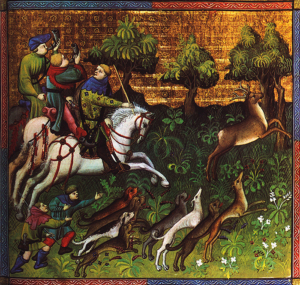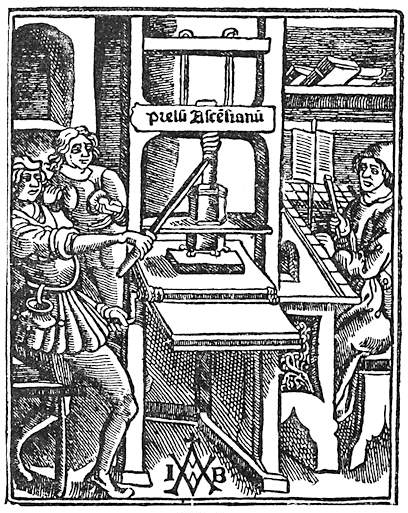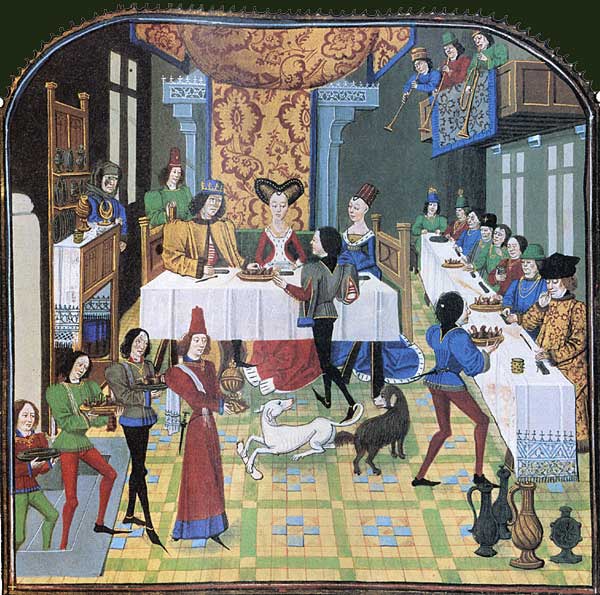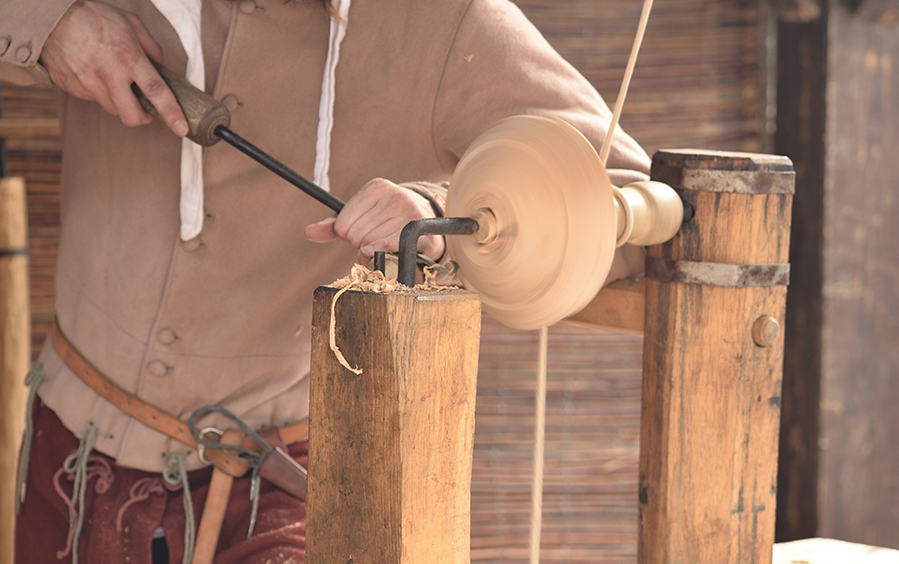Belina Lansac’s way of life
Life five hundred years ago was very different in many ways from now. Think about it. How would you survive without social media, internet, electricity, motor cars, fridge, freezer . . .? However, the late 15th century was a time of innovation because of the invention of printing and the increasing use of paper. In that way, it was similar to the introduction of the internet in our times. Ideas could be exchanged, trade was easier, knowledge of the outside world increased.
Nevertheless, the daily task of cooking food was time and energy consuming. Firewood had to be obtained and lit and managed according to the type of cooking. Cauldrons could sit on a slow burning area while in another zone a fish or an egg could be fried quickly – if you knew how to manage both the cooking and the fire, or had help to do that.
Gascony was already known for its good quality bread. The main dish was garbure, which was – and still is – a cabbage and vegetable stew, simmered with preserved duck or goose or salt pork. It is also the traditional dish of Ecuador. Click here for a modern recipe to make your own garbure.
Except in times of famine, there was not a vast difference between the table of a minor village squire and that of his subjects. They all ate vegetables, lots of bread, and meat. But the Church dictated abstinence from meat and all other animal products every week on Wednesdays, Fridays, and Saturdays, on the eve of festivals, and during the forty days of Lent.
Feast Days for noble and bourgeois households were times for banquets, and rich people could indulge in some splendid food. People washed their hands before their meal. Beakers of wine were shared. Dogs and cats sat on the floor under the table. Servants strode in bearing dishes of pheasants, swans, geese and other poultry - because birds, and the people who ate them, were considered to be nearer to Heaven.
Click here for a recipe for pheasant, and Click here for a recipe for a grete pye for Christmas feasts.
Spices were expensive and were NOT used to camouflage meat that had gone off (another 19th century myth). Well-off farmers, millers and urban people ate lamb, mutton and pork. Belina and Guillaume Lansac mostly ate eggs and cheese (Click here for a recipe for eggs with mustard sauce).
Rivers were full of fish, pike for example. Click here for a recipe for chaudumé of pike. When I lived in Kent, my neighbours’ teenage son would sometimes give me a pike which he had just caught in the river Medway. Very fresh – and sometimes still alive and biting! I wish I had known about this recipe.
Many people had no means of cooking at home. Professional pastry cooks would make large and small pasties and these would be sold on trays in the street. Belina often bought them. Click here for a recipe for Lombard chicken pasties.
Everyone kept chickens. Click here to discover how and why they did.
Fires can be dangerous and the medieval housewife had to know first aid (click here for some methods) and she had to do the washing and ironing, or supervise others doing such onerous tasks. Click here to read more
The medieval housewife also had to know safe ways of clothes storage and pest control. Click here to read more
Cats were popular pets in medieval times, especially in flour mills because they protected the grain from mice and rats. Belina, Jordi and Catalina cherished their cats for that reason but also for companionship. Exeter Cathedral had cats on its payroll and a cat-sized hole through the north transept wall. Presumably, Condom Cathedral also employed cats to keep down rodents. However, the tower was in such a bad state in the fifteenth century that the cats had many entrances.
There is a legend in the village of La Romieu, not far from Condom, which dates to a famine in 1342. The starving residents had eaten all the cats and it was forbidden to keep any. But a little girl called Angeline begged her parents to let her hide her own two cats. With the disappearance of all the cats in the village rats took it over and started eating all the remaining crops until Angeline released her two cats and they quickly killed off all the rats. Stone statues of cats have been placed throughout La Romieu as reminders of the Legend of Angeline.
Men went hunting, for sport and for food. Gascony still had many forests but there were laws about who was allowed to hunt where and what Click here to read more about hunting. The rivers contained an enormous amount of fish, but fishing was a commercial task not a sport. There were many days in the year when meat eating was forbidden: every Wednesday, Friday and Saturday; on the eve of festivals; during the forty days of Lent.
GARBURE
Ingredients – serves 8
- 200 g white haricot beans (cannellini beans)
- 5 carrots
- 3 white turnips
- 1 bunch leeks
- 1 onion stuck with 2 cloves
- 2 cloves garlic, peeled
- 1 bouquet garni
- 1 large savoy cabbage
- 4 large potatoes
- 8 preserved goose or duck legs or 1 piece of salt pork
- 1 heel of ham
- Salt and pepper
Boil the beans in a large stewpan for 15 minutes. Discard the water and refill the pan with water until three-quarters full. Add the preserved or salted meat, heel of ham, onion, garlic and bouquet garni. Do not cover the pan. Bring it to the boil while you peel the carrots, turnips and leeks and cut into small pieces. Add to the pan, cover and simmer for one hour. Add the cabbage and potatoes. Continue cooking for a further 30 minutes then season with salt and pepper. Remove the bouquet garni and onion. Serve with toasted slices of brown bread.
Preparation time: 30 minutes Cooking time: approx. 2 hours
MEDIEVAL CHICKENS
They were omnivores. They ate seeds, grass, leaves, soil, insects, rodents, slugs, snails. Also, wheat, beans, lentils (same food as humans ate). Keeping hens was cheaper than keeping geese and they were too small and weak to destroy crops. They helped to fertilise farms. They could be watched over by children. Their average life was seven years. Modern hens lay 300 eggs per year but medieval ones laid less than that. Cocks were castrated, becoming capons, in March or between 15 Aug (Assumption) and 8 Sept (Nativity of Virgin Mary).
There were many predators: foxes, pigs, dogs, polecats, curlews, buzzards, humans.
In manors chickens lived in lean-to additions to the main grain storage barns, or sometimes in dovecotes with the lord’s pigeons. On smaller farms, peasants kept hens and geese, a few pigs, two sheep, sometimes a pair of oxen or horses. In towns chickens lived outside the house, in the yard, in domed structures made of wattle and daub (interwoven sticks and branches covered with mixture of mud, straw, and animal hair). Peasants took some hens to market, and kept others for their eggs which were cooked in soups, stews, spit-roasted, baked into pies. Old hens were boiled in soup with vegetables. Selective breeding did not start until 16th century.
MEDIEVAL FIRST AID
- Fever – make a powder of ½ oz. pepper, ½ oz. kermes (female insects living in evergreen oaks), ½ oz. ginger, 2-3 raisins; put in same amount of mustard and grind everything small in a mortar; stir in 6 spoonfuls of vinegar and ⅓ quart of stale ale; boil and reduce; sip it for 3 days; when patient is recovered put on fresh sheets and cover warmly.
- Cough or cold – wash feet each evening with hot water; warm soles before the fire; mix together garlic and a little horehound; anoint feet with it and warm soles in front of fire before going to bed.
- Headache – mix together incense with 1 oz. pigeon’s dung and 1 oz. wheat flour; add white of egg; place it where head hurts and ache will vanish.
- Eye ache – put fresh cheese upon the eyes OR anoint the eyes with milk of 2 women (mother & daughter).
- Toothache – boil ivy berries in vinegar; put liquid hot into mouth and keep it there till cold; then spit it out.
- Ointment for burns – fry together pure hen’s dung and fresh pig grease; press them and draw through a cloth; anoint the sore.
- Jelly for burns – take 1 quart of sweet cream and 1 handful of washed fern roots cut up small; boil together in earthenware pot until it turns to jelly; keep it carefully and use when required.
- Ointment to heal a sore – crush red cabbage; mingle it with sour dough and honey; lay ointment on the sore.
- Dog bites – take roast garlic and onions; crush them with honey; lay the ointment on the bite; on top of that put a plaster of boiled mallows.
- Spider bites – take flies and rub well on to the place.
- To make hair grow – crush red onions till small; anoint the bare place. OR take cow dung and old soles of shoes and burn them to a powder in a new earthenware pot; mingle with raw honey and make an ointment; anoint head with this and cover with a leather cap for 9 days.
WASHING AND IRONING CLOTHES
Washing: powder was made by mixing two cups of sieved ashes in a litre of water; left to soak overnight ; filtered and mixed with boiling water; after washing, sheets etc were rinsed in the river or lake, beating them very hard.
In medieval times outer clothes were not washed often, merely shaken and brushed. Underclothes were rinsed frequently and hung to dry over a pole. Woollen clothes with a long nap could be re-shorn when they were dirty (skilled procedure). Soapwort (saponaria) was a medieval detergent.
In medieval times outer clothes were not washed often, merely shaken and brushed. Underclothes were rinsed frequently and hung to dry over a pole. Woollen clothes with a long nap could be re-shorn when they were dirty (skilled procedure). Soapwort (saponaria) was a medieval detergent.
Garments were waterproofed by waxing.
Instructions for stain removal using fuller’s earth soaked in lye: let it dry and then rub stain. Or ashes soaked in lye. Silk soaked and washed in verjuice (acidic juice made by pressing unripe grapes). To remove grease and oil: take urine and heat until warm. Soak stain for two days. Without twisting the fabric, squeeze the afflicted area, then rinse. As an alternative for stubborn greasy or oil stains, soak in urine with ox gall beaten into it, for two days and squeeze without twisting before rinsing. OR: Soak chicken feathers in very hot water and then wet again in cold water; rub stain with these feathers.
Colour was restored to faded garments by rubbing with damp sponge dipped in clear, clean lye.
Clothes were re-hemmed to extend wear and new bits were added to a dress.
Ironing involved holding a flatiron over or in a fire – or on a box containing coals to retain radiant heat for longer – and when it was heated it was picked up by the handle with a padded holder. A thin cloth was placed between the iron and the garment in order not to dirty the clothing during ironing.
CLOTHES STORAGE AND PEST CONTROL
Furs or fur skins were revived by removing fur from garment and sprinkling it with wine. Then spat on. Flour was rubbed into the wetted parts and then the furs or fur skins were dried for a day or two.
Clothes were aired in summer. Sieved rose petals were scattered on them and then the clothes were very tightly wrapped and stored inside chests. Lavender, rue, rosemary, wormwood, iris, valerian, bay leaves, cypress wood were also used.
Fleas were a major problem. Fleas were combed out of hair when the sufferer was standing by an open window. Fleas were caught with flea traps made of alder leaves (crushed like cabbage leaves), made up into cakes like woad. Belina had to wash the cakes, break them up like wax, knead them in running water, put the mixture in a pot and keep the pot well-covered.
Nits and lice also sucked blood. There were several ways of destroying them:
- Wash your head with bryony
- Make quicklime into a powder, mix it with vinegar and anoint head with it
- Use the juice of a herb called blight
- Take a broad strip of cloth as long as a girdle and anoint one side with grease mingled with quicksilver; spread powder of lichen on it and press on it with finger so that it sticks; fold it together and sew the sides; put it inside a linen cloth and sew that; wear it and the lice and the nits will die
Flies left at dawn through an east-facing little opening in the wall. Other methods of getting rid of flies were:
- Put bowls of milk and a hare’s gall in places where flies gathered
- Put a rag smeared with honey on the bottom of a pot
- Take raw onions and shred them, and put them where flies gathered
- Hang a string soaked with honey so that flies are stuck on it; remove them in a bag in the evening
Ants were killed or discouraged by sprinkling with sawdust from oak planks or by placing an owl’s heart on the ants nest, or dried fish, or a mixture of vinegar and ashes.
MEDIEVAL HUNTING

According to a manuscript by Gaston Phebus, there were stags, deer, roe buck, hare, wild rabbit (‘of an idle and roving disposition’), wild boar, bear (‘so timid’), wolf (‘hunted for fur’), fox (‘countryside’s thief’), badger, wildcat (‘hounds frightened of them’), otters caught in nets.
Huntsman training began aged seven. They learnt to make nets to ensnare game. They exercised dogs and trained hounds for the hunt. They learnt to recognise stags by their footprints.
Rabbits were hunted by putting nets over all but one hole in a rabbit warren. A muzzled ferret was sent down that hole and rabbits rushed up their tunnels and into the nets draped over the holes.
Nobles hunted on horseback whereas peasants made game traps with bait: pits, nooses, wallowing in mud, putting needles in meat left near wolves, two thick circular fences.
Animals were shot with bows and crossbows. Carts were camouflaged with leaves, with huntsmen inside the carts and on top of them. Cart wheels were deliberately made squeaky so that all other noises were masked.
Hares were caught in nets set before dawn to catch them on their way back to their warren in the morning. Nobles were against the cruel snares that were used by peasants.
GRETE PYE FOR CHRISTMAS
Ingredients
- 450 gr shortcrust pastry
- 1 egg white, beaten until liquid
- 450 gr boned breasts of chicken, pigeon or wild duck, and/or saddle of hare or rabbit
- 450 gr minced beef
- 2 tbsp shredded suet
- 3 hard-boiled egg yolks, crumbled
- Spice mixture made with ¼ tsp each ground cinnamon and mace, pinch of ground cloves
- 25 gr stoned cooking dates, chopped
- 25 gr currants
- 50 gr stoned prunes, soaked and drained
- 125 ml beef stock
- 1 tbsp cornflour
- Salt and pepper
Use just over half the pastry to line a 23 cm pie plate. Brush the inside with some of the egg white. Skin pieces of breast and other meat if necessary and parboil them gently in salted water for 10-15 minutes. Drain and leave to cool. Mix together in a bowl minced beef, suet, salt and pepper, the egg yolks and half the spice mixture. Add the rest of the spices to the dried fruit in another bowl. Slice the parboiled meat. Pre-heat oven to 220°C, Gas Mark 7.
Add 1-2 tbsp beef stock to cornflour in small saucepan and cream them together; then add remaining stock and stir over gentle heat until slightly thickened. Keep aside.
Cover the bottom of the pastry case with half the mince mixture. Arrange the sliced meat in a flat layer on top. Scatter the chopped spiced fruit over it and cover with the remaining mince. Pour the thickened stock over the lot.
Roll out the remaining pastry into a round to make a lid for the pie. Brush the rim of the case with a little more egg white and cover with the lid. Press the edges to seal, and make escape slits for steam. Decorate with the pastry trimmings and glaze with egg white. Bake for 15 minutes, then reduce the heat to 160°C, Gas Mark 3 and bake for 45-50 minutes longer.
ROAST PHEASANT - 6 servings
Ingredients
- 2 young pheasants
- 1 tbsp butter
- 2 small shallots, peeled
- 2 rashers streaky bacon
- Seasoned flour for dredging
Pre-heat oven to 200°C, Gas Mark 6. Put half the butter and a shallot inside each pheasant and cover the breast with a rasher of bacon. Wrap each bird in a separate piece of foil and put them side by side on a rack in a roasting tin and roast in oven for 30 minutes. Remove them from oven, take off the foil and dredge with seasoned flour, baste and return to oven for another 10 minutes, by which time they should be golden brown.
EGGS WITH MUSTARD SAUCE - 2 servings
Ingredients
- 4 eggs
- 2 slices brown bread, grilled or toasted
- 2 medium onions
- ¼ litre red wine
- 1.5 cl water
- 1 tbsp mustard
- olive oil
- salt
Peel and slice the onions, then sauté until golden in a little olive oil. Reserve.
Fry eggs, sunny side up, in 3 large tbsp olive oil; reserve on a warm plate.
To the same pan add the sautéed onions, the wine, the water, a little salt, and boil until the sauce is somewhat reduced. Dip both sides of the bread into this sauce; the bread should absorb some of the liquid but not become sodden. Place one slice of bread on each plate. Now stir the mustard into the sauce, bring to the boil, and remove from the heat.
Set one fried egg on each slice of bread and top with some of the mustard sauce.
CHAUDUMÉ OF PIKE - or salmon or hake
Ingredients
- 1 slice brown bread
- 20 cl broth from cooking dried peas or beans, or plain water
- 1 pike (1 kg)
- 10 tbsp white wine (15 cl)
- 10 cl verjuice or juice of 1 lemon plus 3 tbsp of water
- 1 tsp ground ginger or a thick slice of fresh ginger minced to a puree
- 50 gr butter cut into small cubes
- 3 or 4 threads of saffron
- Salt
Grill or toast the bread; cut it into pieces and soak in the broth or water. Clean, wash, and dry the fish; salt it inside and out. When the bread has softened, add the wine and verjuice (or diluted lemon juice). Puree it by forcing it through a sieve or in a food processor. Grill the fish, turning once. While the fish is cooking, bring the bread sauce to the boil and simmer gently for 10-15 minutes, or until it thickens slightly. Check for salt, then add the ginger and saffron. Off the heat, swirl in the butter to bind and smooth the sauce. When the fish is done, transfer it into the pan with the sauce, and baste it. Reheat without boiling, and serve.
LOMBARD CHICKEN PASTIES - 6 servings
Ingredients
- 350 gr shortcrust or puff pastry
- 2 eggs, beaten
- 2 tbsp verjuice, or lemon juice (or juice of Seville oranges)
- ⅛ tsp ground black pepper
- ½ tsp ground ginger
- 450 gr chicken breasts, in small thick slices
- 3 large rashers of bacon, without fat and cut in half
Roll out the pastry and cut it into six large circles each 16 cm across. ‘Rest’ it while making the filling. Pre-heat oven to 220°C, Gas Mark 7.
Mix the beaten eggs with the verjuice or lemon juice, pepper and ginger. Dip the chicken slices in the mixture, then divide them between the pastry circles, placing them on one side of the round, but not right up to the edge. Lay a piece of bacon on each pile. Brush the edge of the pastry with the remaining egg mixture (if necessary, use a third egg). Fold the bare half of each pastry round over the meat and match the two pastry edges. Pinch the edges together, fluting them, or press with a fork. Prick the pastry in several places.
Bake the pastries on a baking sheet for 15 minutes. Reduce the oven temperature to 190°C, Gas Mark 5, and cook for another 20-25 minutes. Serve hot or cold.
BOOKS ON MEDIEVAL COOKERY
- The Medieval Kitchen by Odile Redon, Françoise Sabban and Silvano Serventi, translated by Edward Schneider (1991, 1998)
- The Art of Cookery in the Middle Ages by Terence Scully (1995)
- A Culinary History of Food, edited by Jean-Louis Flandrin and Massimo Montanari, translated by Albert Sonnenfeld (1996, 1999)
- Cooking in Europe, 1250-1650 by Ken Albala (2006)
- Consider the Fork – A History of How We Cook and Eat by Bee Wilson (2012)
The first epidemic of the plague was in the 6th century. The second one was in 1347, coming to Europe from Central Asia. It was thought to be a problem in the atmosphere and possibly caused by a ‘conjunction of Saturn, Jupiter and Mars in the house of Aquarius’. Medieval doctors studied astrology as well as medicine. It was not until 1894 that a Swiss doctor, Dr Alexander Yersin, discovered that rats were the main source of the plague.
The plague returned from time to time and it was endemic in Venice from 1477-1498. It was in Perugia, Mallorca, and Valencia in 1475 and in Königsberg the following year. In 1478 there was plague throughout Europe, with 6,662 people dying from it in Venice, and 2,000 more dying elsewhere having fled from Venice. 1479 was another very bad year for the plague, and Mathurin Lussan died of it (in A Mystery of Blood and Dust). So did John Paston (in The Paston Letters). 14,000 people died in the Hotel-Dieu, Paris in 1481 and the plague did not end until 1482 in Paris and Perpignan.
Medieval people tried to flee from the plague. They held religious processions, and in 1483 Barcelona and Gerona sent representatives to Santiago de Compostela, praying especially to St Roch (a plague victim) and imploring St James to lift the plague from their cities. Gascons in Condom would have known about the continued risk from the plague. It was a problem added to two years of very bad winters and floods.




